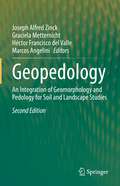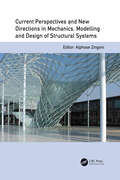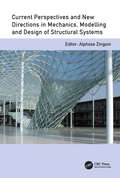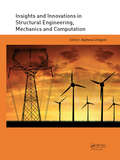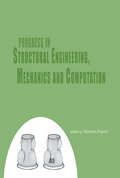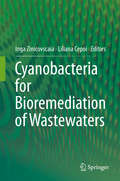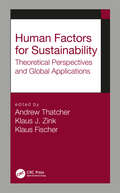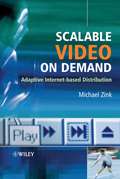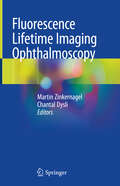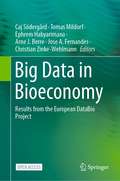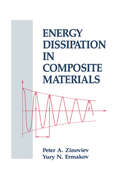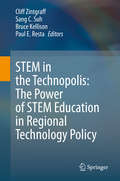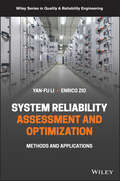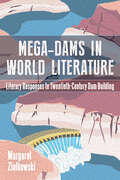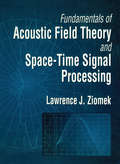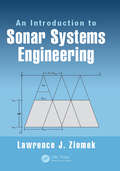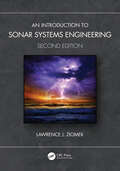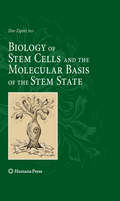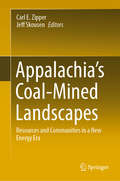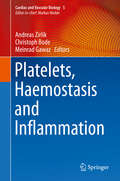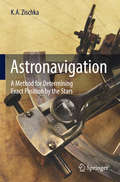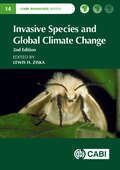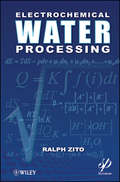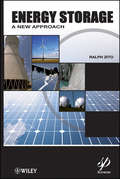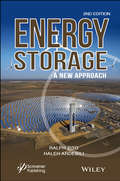- Table View
- List View
Geopedology: An Integration of Geomorphology and Pedology for Soil and Landscape Studies
by Joseph Alfred Zinck Graciela Metternicht Héctor Francisco del Valle Marcos AngeliniThis updated and revised second edition brings geopedology issues into the current context. This new edition extends the work on popular topics such as digital soil mapping, GIS and landscape mapping, and it also gives valuable insight with up-to-date theoretical discussions and new application with relevant case studies. This textbook offers a proven approach for reliable mapping of soil-landscape relationships to derive information for policy, planning and management at scales ranging from local to regional. Filled with didactic elements such as case studies, visual aids (maps, charts and figures), questions and answers, the book is of interest to geohazard studies, land use conflict analysis, land use planning, land degradation assessment, and land suitability analysis. Soil is a vital resource for society at large and an important determinant of the economic status of nations. The intensification of natural disasters and the increased land use competition for food and energy have raised awareness of the relevant role the pedosphere plays in natural and anthropogenic environments. Recent papers and global initiatives show a renewed interest in soil research and its applications for improved planning and management of this fragile and finite resource.
Current Perspectives and New Directions in Mechanics, Modelling and Design of Structural Systems: Proceedings of The Eighth International Conference on Structural Engineering, Mechanics and Computation, 5-7 September 2022, Cape Town, South Africa
by Alphose ZingoniCurrent Perspectives and New Directions in Mechanics, Modelling and Design of Structural Systems comprises 330 papers that were presented at the Eighth International Conference on Structural Engineering, Mechanics and Computation (SEMC 2022, Cape Town, South Africa, 5-7 September 2022). The topics featured may be clustered into six broad categories that span the themes of mechanics, modelling and engineering design: (i) mechanics of materials (elasticity, plasticity, porous media, fracture, fatigue, damage, delamination, viscosity, creep, shrinkage, etc); (ii) mechanics of structures (dynamics, vibration, seismic response, soil-structure interaction, fluid-structure interaction, response to blast and impact, response to fire, structural stability, buckling, collapse behaviour); (iii) numerical modelling and experimental testing (numerical methods, simulation techniques, multi-scale modelling, computational modelling, laboratory testing, field testing, experimental measurements); (iv) design in traditional engineering materials (steel, concrete, steel-concrete composite, aluminium, masonry, timber); (v) innovative concepts, sustainable engineering and special structures (nanostructures, adaptive structures, smart structures, composite structures, glass structures, bio-inspired structures, shells, membranes, space structures, lightweight structures, etc); (vi) the engineering process and life-cycle considerations (conceptualisation, planning, analysis, design, optimization, construction, assembly, manufacture, maintenance, monitoring, assessment, repair, strengthening, retrofitting, decommissioning). Two versions of the papers are available: full papers of length 6 pages are included in an e-book, while short papers of length 2 pages, intended to be concise but self-contained summaries of the full papers, are in this printed book. This work will be of interest to civil, structural, mechanical, marine and aerospace engineers, as well as planners and architects.
Current Perspectives and New Directions in Mechanics, Modelling and Design of Structural Systems: Proceedings of The Eighth International Conference on Structural Engineering, Mechanics and Computation, 5-7 September 2022, Cape Town, South Africa
by Alphose ZingoniCurrent Perspectives and New Directions in Mechanics, Modelling and Design of Structural Systems comprises 330 papers that were presented at the Eighth International Conference on Structural Engineering, Mechanics and Computation (SEMC 2022, Cape Town, South Africa, 5-7 September 2022). The topics featured may be clustered into six broad categories that span the themes of mechanics, modelling and engineering design: (i) mechanics of materials (elasticity, plasticity, porous media, fracture, fatigue, damage, delamination, viscosity, creep, shrinkage, etc); (ii) mechanics of structures (dynamics, vibration, seismic response, soil-structure interaction, fluid-structure interaction, response to blast and impact, response to fire, structural stability, buckling, collapse behaviour); (iii) numerical modelling and experimental testing (numerical methods, simulation techniques, multi-scale modelling, computational modelling, laboratory testing, field testing, experimental measurements); (iv) design in traditional engineering materials (steel, concrete, steel-concrete composite, aluminium, masonry, timber); (v) innovative concepts, sustainable engineering and special structures (nanostructures, adaptive structures, smart structures, composite structures, glass structures, bio-inspired structures, shells, membranes, space structures, lightweight structures, etc); (vi) the engineering process and life-cycle considerations (conceptualisation, planning, analysis, design, optimization, construction, assembly, manufacture, maintenance, monitoring, assessment, repair, strengthening, retrofitting, decommissioning). Two versions of the papers are available: full papers of length 6 pages are included in the e-book, while short papers of length 2 pages, intended to be concise but self-contained summaries of the full papers, are in the printed book. This work will be of interest to civil, structural, mechanical, marine and aerospace engineers, as well as planners and architects.
Insights and Innovations in Structural Engineering, Mechanics and Computation: Proceedings of the Sixth International Conference on Structural Engineering, Mechanics and Computation, Cape Town, South Africa, 5-7 September 2016
by Alphose ZingoniInsights and Innovations in Structural Engineering, Mechanics and Computation comprises 360 papers that were presented at the Sixth International Conference on Structural Engineering, Mechanics and Computation (SEMC 2016, Cape Town, South Africa, 5-7 September 2016). The papers reflect the broad scope of the SEMC conferences, and cover a wide range of engineering structures (buildings, bridges, towers, roofs, foundations, offshore structures, tunnels, dams, vessels, vehicles and machinery) and engineering materials (steel, aluminium, concrete, masonry, timber, glass, polymers, composites, laminates, smart materials).
Progress in Structural Engineering, Mechanics and Computation: Proceedings of the Second International Conference on Structural Engineering, Mechanics and Computation, Cape Town, South Africa, 5-7 July 2004
by Alphose ZingoniThe Second International Conference on Structural Engineering Mechanics and Computation was held in Cape Town, South Africa in 2004. Its mission was 'To review and share the latest developments, and address the challenges that the present and the future pose'.This book contains its key findings with contributions from academics, researchers and pra
Cyanobacteria for Bioremediation of Wastewaters
by Inga Zinicovscaia Liliana CepoiThis book reflects the use of cyanobacteria for the bioremediation of wastewater through different mechanisms and pathways of transformation and transfer of hazardous substances from one medium to another. The application of microorganisms for bioremediation is determined by their ubiquity, small size, high rate of reproduction and large surface-to-volume cell ratio. Mechanisms of interaction of cyanobacteria with inorganic pollutants include biosorption, bioaccumulation with an opportunity to obtain metal nanoparticles both on the cell surface and inside the cells as well as chelation and inclusion of metals in the composition of certain organic structures. Data presented in the book provides specialists in the field with useful information for bioremediation technologies as well as for obtaining valuable preparations using cyanobacteria.
Human Factors for Sustainability: Theoretical Perspectives and Global Applications
by Klaus J. Zink Andrew Thatcher Klaus FischerThis book deals with the central question of how human factors and ergonomics (HFE) might contribute to solutions for the more sustainable development of our world. The contents of the book are highly compatible with the recent political agenda for sustainable development as well as with sustainability research from other disciplines. <P><P>The book aims to summarize and profile the various empirical and theoretical work arising from the field of “Human Factors and Sustainable Development” in the last decade. The book gives a systematic overview of relevant theoretical concepts, their underlying philosophies, as well as global application fields and case studies.
Scalable Video on Demand
by Michael ZinkIn recent years, the proliferation of available video content and the popularity of the Internet have encouraged service providers to develop new ways of distributing content to clients. Increasing video scaling ratios and advanced digital signal processing techniques have led to Internet Video-on-Demand applications, but these currently lack efficiency and quality.Scalable Video on Demand: Adaptive Internet-based Distribution examines how current video compression and streaming can be used to deliver high-quality applications over the Internet. In addition to analysing the problems of client heterogeneity and the absence of Quality of Service in the Internet, this book:assesses existing products and encoding formats;presents new algorithms and protocols for optimised on-line video streaming architectures;includes real-world application examples and experiments;sets out a practical 'toolkit' for Dynamically Reconfigurable Multimedia Distribution Systems.Written by an expert in the field of video distribution, Scalable Video on Demand: Adaptive Internet-based Distribution provides a novel approach to the design and implementation of Video-on-Demand systems for Software Engineers and researchers. It will also be useful for graduate students following Electronic Engineering and Computer Science courses.
Fluorescence Lifetime Imaging Ophthalmoscopy
by Martin Zinkernagel Chantal DysliThis book focuses on the emerging non-invasive imaging technique of Fluorescence Lifetime Imaging Ophthalmoscopy (FLIO). FLIO reveals unique information on retinal diseases, ranging from age-related macular degeneration and vascular diseases to hereditary retinal dystrophies. Fluorescence lifetimes enable the evaluation of disease progression before irreversible structural changes occur. The image acquisition is suitable for diagnostic purposes and follow-up examinations to investigate the natural course of disease, and to monitor the effects of possible therapies. This book fills the gap between available literature and gives state-of-the-art guidance on the principles of the FLIO technique, image acquisition, and data analysis. Written by a team of expert leaders within this field, this book will be relevant for scientists and clinicians with an interest in ophthalmoscopy.
Big Data in Bioeconomy: Results from the European DataBio Project
by Christian Zinke-Wehlmann Caj Södergård Tomas Mildorf Ephrem Habyarimana Arne J. Berre Jose A. FernandesThis edited open access book presents the comprehensive outcome of The European DataBio Project, which examined new data-driven methods to shape a bioeconomy. These methods are used to develop new and sustainable ways to use forest, farm and fishery resources. As a European initiative, the goal is to use these new findings to support decision-makers and producers – meaning farmers, land and forest owners and fishermen.With their 27 pilot projects from 17 countries, the authors examine important sectors and highlight examples where modern data-driven methods were used to increase sustainability. How can farmers, foresters or fishermen use these insights in their daily lives? The authors answer this and other questions for our readers. The first four parts of this book give an overview of the big data technologies relevant for optimal raw material gathering. The next three parts put these technologies into perspective, by showing useable applications from farming, forestry and fishery. The final part of this book gives a summary and a view on the future.With its broad outlook and variety of topics, this book is an enrichment for students and scientists in bioeconomy, biodiversity and renewable resources.
Energy Dissipation in Composite Materials
by Peter A. Zinoviev Yury N. ErmakovAll real materials in one way or another, exhibit a departure from ideal elastic behaviour, even at very small strain values. Under cyclic deformation, these departtures result in irreversible energy losses in material. The causes of such losses are many, and include the irreversible transfer of mechanical energy into heat, growth of cracks and other defects, and the microplastic deformaton of crystals to name a few. Several terms have been suggested to define these phenomena including damping, energy dissipation, imperfect elasticity and internal friction. This book is about materials damping; with damping or energy dissipation processes in vibrating solids.
STEM in the Technopolis: The Power of STEM Education in Regional Technology Policy
by Cliff Zintgraff Sang C. Suh Bruce Kellison Paul E. RestaThis book addresses how forward-thinking local communities are integrating pre-college STEM education, STEM pedagogy, industry clusters, college programs, and local, state and national policies to improve educational experiences, drive local development, gain competitive advantage for the communities, and lead students to rewarding careers. This book consists of three sections: foundational principles, city/regional case studies from across the globe, and state and national context. The authors explore the hypothesis that when pre-college STEM education is integrated with city and regional development, regions can drive a virtuous cycle of education, economic development, and quality of life.Why should pre-college STEM education be included in regional technology policy? When local leaders talk about regional policy, they usually talk about how government, universities and industry should work together. This relationship is important, but what about the hundreds of millions of pre-college students, taught by tens of millions of teachers, supported by hundreds of thousands of volunteers, who deliver STEM education around the world? Leaders in the communities featured in STEM in the Technopolis have recognized the need to prepare students at an early age, and the power of real-world connections in the process. The authors advocate for this approach to be expanded. They describe how STEM pedagogy, priority industry clusters, cross-sector collaboration, and the local incarnations of global development challenges can be made to work together for the good of all citizens in local communities. This book will be of interest to government policymakers, school administrators, industry executives, and non-profit executives. The book will be useful as a reference to teachers, professors, industry professional volunteers, non-profit staff, and program leaders who are developing, running, or teaching in STEM programs or working to improve quality of life in their communities.
Reliability Analysis, Safety Assessment and Optimization: Methods and Applications in Energy Systems and Other Applications (Quality and Reliability Engineering Series)
by Enrico Zio Yan-Fu LiThis book is a comprehensive overview of the recently developed methods for assessing and optimizing system reliability and safety. It consists of two main parts, for assessment and optimization methods, respectively. The former covers multi-state system modelling and reliability evaluation, Markov processes, Monte Carlo simulation and uncertainty treatments under poor knowledge. The reviewed methods range from piecewise-deterministic Markov process to belief functions. The latter covers mathematical programs, evolutionary algorithms, multi-objective optimization and optimization under uncertainty. The reviewed methods range from non-dominated sorting genetic algorithm to robust optimization. This book also includes the applications of the assessment and optimization method on real world cases, particularly for the reliability and safety of renewable energy systems. From this point of view, the book bridges the gap between theoretical development and engineering practice.
Mega-Dams in World Literature: Literary Responses to Twentieth-Century Dam Building
by Margaret ZiolkowskiMega-Dams in World Literature reveals the varied effects of large dams on people and their environments as expressed in literary works, focusing on the shifting attitudes toward large dams that emerged over the course of the twentieth century. Margaret Ziolkowski covers the enthusiasm for large-dam construction that took place during the mid-twentieth-century heyday of mega-dams, the increasing number of people displaced by dams, the troubling environmental effects they incur, and the types of destruction and protest to which they may be subject. Using North American, Native American, Russian, Egyptian, Indian, and Chinese novels and poems, Ziolkowski explores the supposed progress that these structures bring. The book asks how the human urge to exploit and control waterways has affected our relationships to nature and the environment and argues that the high modernism of the twentieth century, along with its preoccupation with development, casts the hydroelectric dam as a central symbol of domination over nature and the power of the nation state. Beyond examining the exultation of large dams as symbols of progress, Mega-Dams in World Literature takes a broad international and cultural approach that humanizes and personalizes the major issues associated with large dams through nuanced analyses, paying particular attention to issues engendered by high modernism and settler colonialism. Both general and specialist readers interested in human-environment relationships will enjoy this prescient book.
Fundamentals of Acoustic Field Theory and Space-Time Signal Processing
by Lawrence ZiomekProviding a wealth of information on fundamental topics in the areas of linear air and underwater acoustics, as well as space-time signal processing, this book provides real-world design and analysis equations. As a consequence of the interdisciplinary nature of air and underwater acoustics, the book is divided into two parts: Acoustic Field Theory and Space-Time Signal Processing. It covers the fundamentals of acoustic wave propagation as well as the fundamentals of aperture theory, array theory, and signal processing. Starting with principles and using a consistent, mainly standard notation, this book develops, in detail, basic results that are useful in a variety of air and underwater acoustic applications. Numerous figures, examples, and problems are included.
An Introduction to Sonar Systems Engineering
by Lawrence J. ZiomekWritten in tutorial style, this textbook discusses the fundamental topics of modern day Sonar Systems Engineering for the analysis and design of both active and passive sonar systems. Included are basic signal design for active sonar systems and understanding underwater acoustic communication signals. Mathematical theory is provided, plus practical design and analysis equations for both passive and active sonar systems. Practical homework problems are included at the end of each chapter and a solutions manual and lecture slides for each chapter are available for adopting professors.
An Introduction to Sonar Systems Engineering
by Lawrence J. ZiomekAn Introduction to Sonar Systems Engineering Second Edition Important topics that are fundamental to the understanding of modern-day sonar systems engineering are featured. Linear, planar, and volume array theory, including near-field and far-field beam patterns, beam steering, and array focusing, are covered. Real-world arrays such as the twin-line planar array and a linear array of triplets, which are solutions to the port/starboard (left/right) ambiguity problem associated with linear towed arrays, are examined in detail. Detailed explanations of the fundamentals of side-looking (side-scan) and synthetic-aperture sonars are presented. Bistatic scattering with moving platforms is explored with derivations of exact solutions for the time delay, time-compression/time-expansion factor, and Doppler shift at a receiver for both the scattered and direct acoustic paths. Time-domain and frequency-domain descriptions, and the design of CW, LFM, and Doppler-invariant HFM pulses, are explained. Target detection in the presence of reverberation and noise is examined. Time-domain and frequency-domain descriptions of MFSK, MQAM, and OFDM underwater acoustic communication signals are also discussed. Although the book is mathematically rigorous, it is written in a tutorial style. Many useful, practical design and analysis equations for both passive and active sonar systems are derived from first principles. No major steps in the derivation of important results are skipped – all assumptions and approximations are clearly stated. Particular attention is paid to the correct units for functions and parameters. Many figures, tables, examples, and practical homework problems at the end of each chapter are included to aid in the understanding of the material covered. New to the Second Edition Chapter 15 Synthetic-Aperture Sonar Chapter 13, Section 13.3, The Rectangular-Envelope HFM Pulse Chapter 10, Section 10.7, Moving Platforms, was rewritten, which allowed for the elimination of Appendix 10C from the first edition New explanations/discussions were added to Subsections 1.2.1 and 1.3.1 in Chapter 1 Appendix 1A was rewritten and the new Table 1A-1 was added to Chapter 1 A solutions manual is available for adopting professors
Biology of Stem Cells and the Molecular Basis of the Stem State (Stem Cell Biology and Regenerative Medicine)
by Dov ZiporiBiology of Stem Cells and the Molecular Basis of the Stem State concentrates upon adult stem cells, particularly on mesenchymal cell populations, which is the author's area of expertise. The text offers the reader a detailed description of the emergence of stem cell research and the dogmas that were created during the first decades of analysis of stem cell properties, particularly those of hemopoietic stem cells. Biology of Stem Cells and the Molecular Basis of the Stem State also introduces the reader to the commonly accepted notions regarding stem cell biology, with an emphasis on an alternative view of stemness, i.e. the stem state. In keeping with the popularity of this topic, Biology of Stem Cells and the Molecular Basis of the Stem State addresses the major controversies and points of dispute, among researchers in the stem cell field. Overall, Biology of Stem Cells and the Molecular Basis of the Stem State presents a well-rounded dialogue about stem cells as it not only concentrates upon the biological elements of stem cell, but also addresses the controversy and hype currently enveloping this popular subject.
Appalachia's Coal-Mined Landscapes: Resources and Communities in a New Energy Era
by Carl E. Zipper Jeff SkousenThis book collects and summarizes current scientific knowledge concerning coal-mined landscapes of the Appalachian region in eastern United States. Containing contributions from authors across disciplines, the book addresses topics relevant to the region’s coal-mining history and its future; its human communities; and the soils, waters, plants, wildlife, and human-use potentials of Appalachia’s coal-mined landscapes.The book provides a comprehensive overview of coal mining’s legacy in Appalachia, USA. It book describes the resources of the Appalachian coalfield, its lands and waters, and its human communities – as they have been left in the aftermath of intensive mining, drawing upon peer-reviewed science and other regional data to provide clear and objective descriptions. By understanding the Appalachian experience, officials and planners in other resource extraction- affected world regions can gain knowledge and perspectives that will aid their own efforts to plan and manage for environmental quality and for human welfare.Appalachia's Coal-Mined Landscapes: Resources and Communities in a New Energy Era will be of use to natural resource managers and scientists within Appalachia and in other world regions experiencing widespread mining, researchers with interest in the region’s disturbance legacy, and economic and community planners concerned with Appalachia’s future.
Platelets, Haemostasis and Inflammation (Cardiac and Vascular Biology #5)
by Andreas Zirlik Christoph Bode Meinrad GawazThe book depicts the various roles of platelets in a variety of cardio-metabolic diseases. Traditional and non-traditional platelet functions are described in detail in atherosclerosis, metabolic syndrome, diabetes, myocardial infarction, and other vascular pathologies. Particular focus is put on platelets as a link between haemostasis and inflammation contributing to both. Last but not least the books links the most recent advances in basic sciences with promising novel therapeutic applications and first results of clinical trials. The book is written for biomedical scientists in the sub disciplines vascular biology, biochemistry and immunology; and it as well will be of interest and value for academic physicians like cardiologists, hematologists, general internists and vascular surgeons.
Astronavigation: A Method for Determining Exact Position by the Stars
by K. A. ZischkaThis book acts as a manual for the ancient methods of navigating by the stars, which continue to provide the sailor or pilot with a timeless means of determining location. Despite the prevalence of GPS, a comprehensive set of formulae that can be evaluated on any inexpensive scientific calculator in the event of a catastrophic software or systems failure is a vital failsafe. It also serves as a living link to centuries of explorers from centuries past. Beginning with the basics of positional astronomy, this guide moves on to the more complex math necessary to understand the ephemerides, tables showing the future positions of the stars and planets. These astronomical almanacs were the satellite navigation of their day. The objective of this book is twofold: to provide the reader with a concise, comprehensible manual on positional astronomy as it applies to astro-navigation and to furnish the concise algorithms for finding the position of the Sun and various navigational stars at any given instant. In a world where too many mariners and aeronauts rely solely on technology and are vulnerable to solar flares, electrical issues, and the like, this knowledge can be a life-saving backup, not to mention a fascinating study in its own rights. Included is an exact mathematical way to determine your position in the air or on the sea far more quickly and accurately than by using the old celestial navigational method, without even needing to know or understand the underlying mathematics. There is even a section that teaches how to measure the azimuth of a star using an analog wrist watch so if a sextant gets damaged, locating position is still possible. This book offers mathematicians and adventurers a way to determine position when the skies go dark. The U. S. Navy has recently realized that their electronic navigation systems are vulnerable to cyberattack, and as a result has instructed the Naval Academy to begin teaching celestial navigation again.
Invasive Species and Global Climate Change (CABI Invasives Series)
by Lewis H. ZiskaThis book addresses topics related to the impact of invasive species including biosecurity, demographics, species diversity and food security. It is meant for researchers, upper-level students, and policy makers and provides a factual basis for the underlying science and a discussion of that information with respect to current and future impacts and possible solutions. This book explores the nexus of climate change and biological invasions, resulting impacts (biological and economic) and assesses ways to reduce vulnerability and increase the resiliency and sustainability of managed and unmanaged ecosystems. The book has three parts, focusing on: (1) the dimensions of the problem; background and science; (2) case studies; (3) Management: detection, prevention, control and adaptation. This revised edition examines a wide range of topics and region, the underlying science, examples (case studies) from around the world, and ways and means to recognize, manage and control the consequences. It includes new cases and new threats; for example, a chapter summarizing case studies regarding climate change and invasive species that are also disease carriers (e.g. ticks and Lyme disease). - Covers a wide range of topics and areas - Examines the synergy between invasive species and climate change - Explains options to control and mitigate effects This book is of interest to academics, researchers and students studying climate change and invasive species. Those interested in the environment and ecology, land managers, policy makers, agronomists, federal and state departments of natural resources, climate change activists, public health professionals.
Electrochemical Water Processing: A Compendium Of Analyses And Laboratory Notes Based Upon R&d In Electrochemical Energy Systems Technology
by Ralph ZitoEven though most of the Earth’s surface is covered with water, most of it is not directly usable for human consumption or applications. As the population increases and our general style of living standards increase, the importance useable water is becoming acute. This book addresses this issue with approaches to treating water sources that require removal of unwanted or dissolved substances. In particular, it covers various methods for removing dissolved ionic materials. There are numerous methods for accomplishing this end, and the book reviews most of them in some depth.
Energy Storage: A New Approach (Wiley-Scrivener #26)
by Ralph ZitoEnergy Storage: A New Approach presents practical solutions to the problem of energy storage on a massive scale. This revolutionary book describes technologies that include basic chemical concepts that engineers have been practicing for years, but presents new material that could transform the energy industry. Regardless where power is generated from—oil, natural gas, coal, solar, wind, or any of the other emerging sources— energy storage is something that the industry MUST learn and practice. With the world energy demand increasing, mostly due to industrial growth in China and India, and with the West becoming increasingly more interested in fuel efficiency and “green” endeavors, energy storage is potentially a key technology in our energy future.
